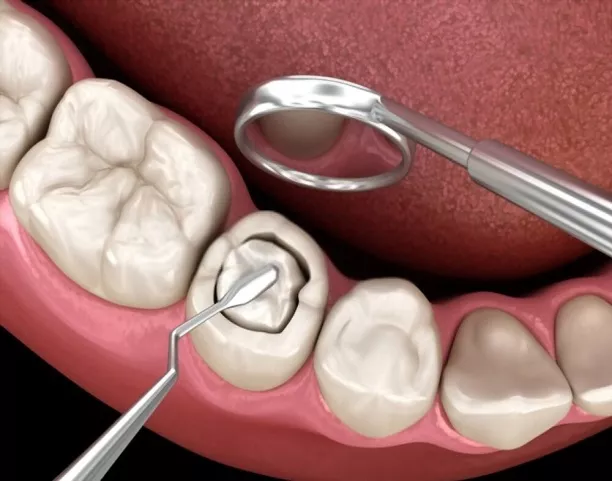WHAT IS DENTAL FILLING OR TEETH FILLINGS?
Dental fillings, often simply referred to as “teeth fillings,” are a common and crucial dental procedure used to repair and restore teeth affected by cavities, cracks, or minor damage. These fillings play a vital role in preserving your oral health and maintaining a beautiful smile.
Cavities, also known as dental caries or tooth decay, occur when the hard outer layer of the tooth, known as enamel, is eroded by acid-producing bacteria. If left untreated, cavities can progress deeper into the tooth, leading to pain, infection, and even tooth loss. Dental fillings are a solution to this problem.






| THE DENTAL FILLING PROCEDURE TYPICALLY INVOLVES THE FOLLOWING STEPS:
1. Examination: Your dentist will first examine your teeth and may use X-rays to assess the extent of the damage or decay.
2. Anesthesia: To ensure your comfort during the procedure, the dentist will numb the affected area with a local anesthetic.
3. Removal of Decay: The dentist will then remove the decayed or damaged portion of the tooth using a dental drill, laser, or air abrasion.
4. Filling Placement: Once the tooth is prepared, the dentist will place the dental filling material into the cavity or on the affected area. There are different types of dental filling materials, including amalgam (silver fillings), composite resin (tooth-colored fillings), gold, and ceramic. The choice of material depends on factors like the location of the filling, your aesthetic preferences, and your dentist’s recommendation.
5. Shaping and Polishing: The dentist will shape the filling to match the natural contours of your tooth and then polish it to ensure a smooth and comfortable fit.
| TYPES OF DENTAL FILLING OR TEETH FILLINGS?
Amalgam Fillings: Amalgam fillings, often referred to as “silver fillings,” are made from a mixture of metals, including silver, tin, copper, and mercury. They are known for their durability and are particularly suitable for filling cavities in molars and premolars due to their strength. However, some people are concerned about the mercury content in amalgam fillings.
Composite Resin Fillings: Composite resin fillings, also known as “tooth-colored” or “white fillings,” are made of a mixture of plastic and fine glass particles. They are popular for their natural appearance, as they can be color-matched to your tooth, making them virtually invisible. Composite fillings are suitable for front and back teeth, although they may not be as durable as amalgam fillings.
Gold Fillings: Gold fillings, also known as inlays or onlays, are made of gold alloy. They are highly durable, resistant to wear, and well-tolerated by gum tissues. Gold fillings are often used in areas of the mouth where biting forces are significant, such as molars. Their distinctive appearance makes them a choice for those who prioritize longevity over aesthetics.
Ceramic Fillings: Ceramic fillings, often made of porcelain, are tooth-colored and highly aesthetic. They are stain-resistant and blend seamlessly with natural teeth. These fillings are an excellent choice for restoring front teeth and areas that are highly visible. They are more brittle than composite or amalgam fillings and may not be as durable for large restorations.
Glass Ionomer Fillings: Glass ionomer fillings are a mixture of acrylic and glass powders. They release fluoride, which can help prevent further decay. They are often used for small fillings, particularly in baby teeth, and as a temporary solution.
Composite and Ceramic Onlays: Onlays are a variation of fillings that cover a larger portion of a tooth’s surface and are used when the damage is extensive but not severe enough to warrant a crown. They can be made from composite or ceramic materials.
Your dentist will consider various factors, including the location and size of the cavity, your aesthetic preferences, and your budget when recommending the most appropriate type of dental filling for your specific needs. It’s essential to discuss these options with your dentist to make an informed decision about which type of filling is best for your oral health and cosmetic goals.
FAQ
Most frequent questions and answers
I am item content. Click edit button to change this text. Lorem ipsum dolor sit amet, consectetur adipiscing elit. Ut elit tellus, luctus nec ullamcorper mattis, pulvinar leo.
The lifespan of dental fillings varies, with amalgam fillings lasting longer than composite or ceramic fillings.
After a filling, you can typically resume your regular eating and drinking habits once the anesthesia wears off.
Fillings are generally safe, with potential side effects being temporary sensitivity or rare allergic reactions.
You can discuss your preferences with your dentist, but the choice of material depends on factors like tooth location and damage extent.


